2007 ISUZU KB P190 check transmission fluid
[x] Cancel search: check transmission fluidPage 3875 of 6020

Automatic Transmission – 4L60E – Electrical Diagnosis Page 7C2–89
Step Action Yes No
7 Using a multimeter set to measure resistance, probe between
connector C-96 pin 40 and a known ground.
Does the multimeter display greater than 250 k Ω? Go to Step 9 Go to Step 8
8 Using a multimeter, test between E-95 pin 2 & C-96 pin 40 and
E-95 pin 1 & C-96 pin 17 for the following:
• open circuit,
• short together, and
• short to ground.
Did you find any of the conditions tested? Repair or replace
the affected circuit
Go to Step 11 —
9 Using a multimeter, test between E-95 pin 1 & E-95 pin 2 and the
solenoid for a short to voltage.
Did you find and correct the condition? Go to Step 11 Go to Step 10
10 Replace the TCM, refer to 7C4 Automatic Transmission – 4L60E –
On-vehicle Servicing.
Did you complete the replacement? Go to Step 11 —
11 Perform the following procedure to verify the repair:
1 On Tech 2 select: Diagnostic Trouble Codes / Clear Engine & Transmission
DTCs.
2 Follow the instructions on Tech 2 and clear any DTCs.
3 On Tech 2 select: Data Display / Pressure Control Solenoid Data.
4 Start the engine and ensure the difference on Tech 2 between the PCS Actual Current and the PCS Desired Current is less
than 16 mA.
5 On Tech 2 select:
Diagnostic Trouble Codes / Read DTC Information.
Has DTC P0961 set? Go to Step 2 Go to Step 20
12 On Tech 2 select:
Diagnostic Trouble Codes / Read DTC Information.
Does Tech 2 display any DTCs you have not diagnosed? Refer to
4.8 Diagnostic Trouble Code List System OK
When all diagnosis and repairs are completed, check the
system for correct operation.
4.28 DTC P0973 – 1-2 Shift Solenoid Control
Circuit Low Voltage
DTC Description
This diagnostic procedure supports DTC P0973 1-2 Shift Solenoid (SS) Control Circuit Low Voltage.
Circuit Description
The 1-2 shift solenoid (SS) valve controls the fluid flow acting on the 1-2 and 3-4 shift valves. The solenoid is a normally-
open exhaust valve. W ith the 2-3 SS valve, the 1-2 SS valve allows four different shifting combinations. The solenoid
attaches to the control valve body within the transmission. The 1-2 SS valve receives ignition voltage through the ignition
voltage circuit. The transmission control module (TCM) controls the solenoid by providing the ground path on the 1-2 SS
valve control circuit.
When the TCM detects a continuous open or short to ground in the 1-2 SS valve circuit, then DTC P0973 sets.
DTC P0973 is a type B DTC.
BACK TO CHAPTER INDEX
TO MODEL INDEX
ISUZU KB P190 2007
Page 3879 of 6020
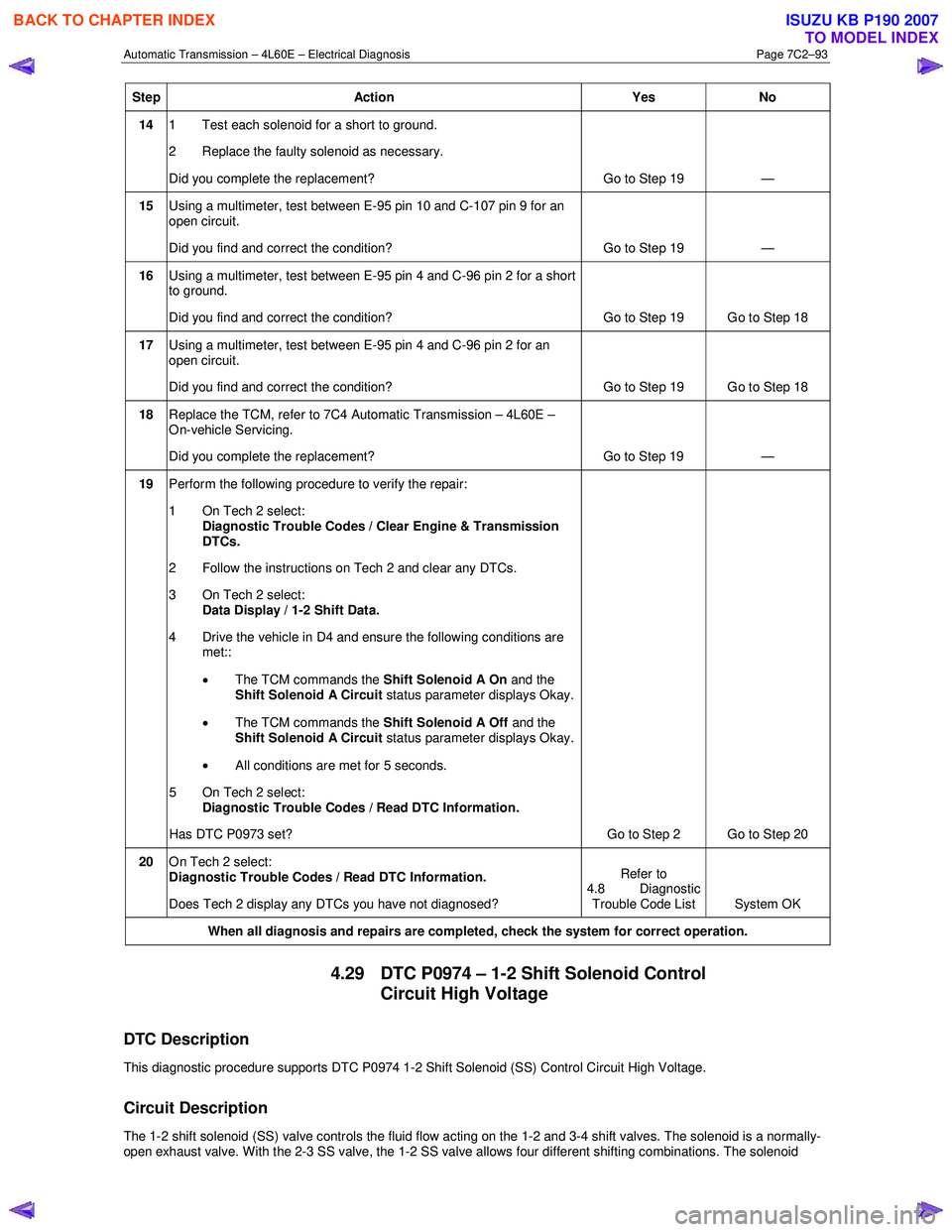
Automatic Transmission – 4L60E – Electrical Diagnosis Page 7C2–93
Step Action Yes No
14 1 Test each solenoid for a short to ground.
2 Replace the faulty solenoid as necessary.
Did you complete the replacement? Go to Step 19 —
15 Using a multimeter, test between E-95 pin 10 and C-107 pin 9 for an
open circuit.
Did you find and correct the condition? Go to Step 19
—
16 Using a multimeter, test between E-95 pin 4 and C-96 pin 2 for a short
to ground.
Did you find and correct the condition? Go to Step 19 Go to Step 18
17 Using a multimeter, test between E-95 pin 4 and C-96 pin 2 for an
open circuit.
Did you find and correct the condition? Go to Step 19 Go to Step 18
18 Replace the TCM, refer to 7C4 Automatic Transmission – 4L60E –
On-vehicle Servicing.
Did you complete the replacement? Go to Step 19 —
19 Perform the following procedure to verify the repair:
1 On Tech 2 select: Diagnostic Trouble Codes / Clear Engine & Transmission
DTCs.
2 Follow the instructions on Tech 2 and clear any DTCs.
3 On Tech 2 select: Data Display / 1-2 Shift Data.
4 Drive the vehicle in D4 and ensure the following conditions are met::
• The TCM commands the Shift Solenoid A On and the
Shift Solenoid A Circuit status parameter displays Okay.
• The TCM commands the Shift Solenoid A Off and the
Shift Solenoid A Circuit status parameter displays Okay.
• All conditions are met for 5 seconds.
5 On Tech 2 select:
Diagnostic Trouble Codes / Read DTC Information.
Has DTC P0973 set? Go to Step 2 Go to Step 20
20
On Tech 2 select:
Diagnostic Trouble Codes / Read DTC Information.
Does Tech 2 display any DTCs you have not diagnosed? Refer to
4.8 Diagnostic Trouble Code List System OK
When all diagnosis and repairs are completed, check the system for correct operation.
4.29 DTC P0974 – 1-2 Shift Solenoid Control
Circuit High Voltage
DTC Description
This diagnostic procedure supports DTC P0974 1-2 Shift Solenoid (SS) Control Circuit High Voltage.
Circuit Description
The 1-2 shift solenoid (SS) valve controls the fluid flow acting on the 1-2 and 3-4 shift valves. The solenoid is a normally-
open exhaust valve. W ith the 2-3 SS valve, the 1-2 SS valve allows four different shifting combinations. The solenoid
BACK TO CHAPTER INDEX
TO MODEL INDEX
ISUZU KB P190 2007
Page 3882 of 6020
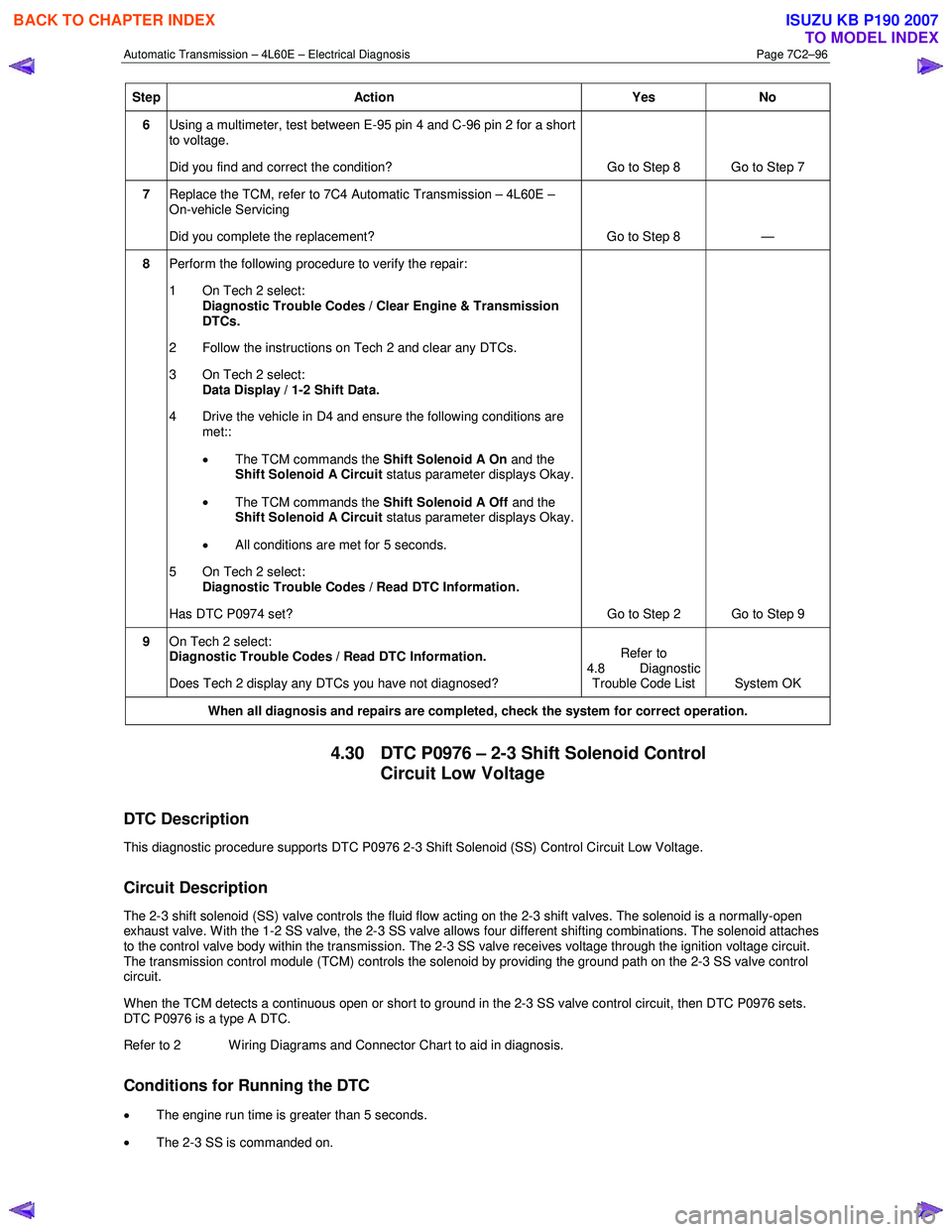
Automatic Transmission – 4L60E – Electrical Diagnosis Page 7C2–96
Step Action Yes No
6 Using a multimeter, test between E-95 pin 4 and C-96 pin 2 for a short
to voltage.
Did you find and correct the condition? Go to Step 8 Go to Step 7
7 Replace the TCM, refer to 7C4 Automatic Transmission – 4L60E –
On-vehicle Servicing
Did you complete the replacement? Go to Step 8 —
8 Perform the following procedure to verify the repair:
1 On Tech 2 select: Diagnostic Trouble Codes / Clear Engine & Transmission
DTCs.
2 Follow the instructions on Tech 2 and clear any DTCs.
3 On Tech 2 select: Data Display / 1-2 Shift Data.
4 Drive the vehicle in D4 and ensure the following conditions are met::
• The TCM commands the Shift Solenoid A On and the
Shift Solenoid A Circuit status parameter displays Okay.
• The TCM commands the Shift Solenoid A Off and the
Shift Solenoid A Circuit status parameter displays Okay.
• All conditions are met for 5 seconds.
5 On Tech 2 select:
Diagnostic Trouble Codes / Read DTC Information.
Has DTC P0974 set? Go to Step 2 Go to Step 9
9 On Tech 2 select:
Diagnostic Trouble Codes / Read DTC Information.
Does Tech 2 display any DTCs you have not diagnosed? Refer to
4.8 Diagnostic Trouble Code List System OK
When all diagnosis and repairs are completed, check the
system for correct operation.
4.30 DTC P0976 – 2-3 Shift Solenoid Control
Circuit Low Voltage
DTC Description
This diagnostic procedure supports DTC P0976 2-3 Shift Solenoid (SS) Control Circuit Low Voltage.
Circuit Description
The 2-3 shift solenoid (SS) valve controls the fluid flow acting on the 2-3 shift valves. The solenoid is a normally-open
exhaust valve. W ith the 1-2 SS valve, the 2-3 SS valve allows four different shifting combinations. The solenoid attaches
to the control valve body within the transmission. The 2-3 SS valve receives voltage through the ignition voltage circuit.
The transmission control module (TCM) controls the solenoid by providing the ground path on the 2-3 SS valve control
circuit.
W hen the TCM detects a continuous open or short to ground in the 2-3 SS valve control circuit, then DTC P0976 sets.
DTC P0976 is a type A DTC.
Refer to 2 W iring Diagrams and Connector Chart to aid in diagnosis.
Conditions for Running the DTC
• The engine run time is greater than 5 seconds.
• The 2-3 SS is commanded on.
BACK TO CHAPTER INDEX
TO MODEL INDEX
ISUZU KB P190 2007
Page 3886 of 6020
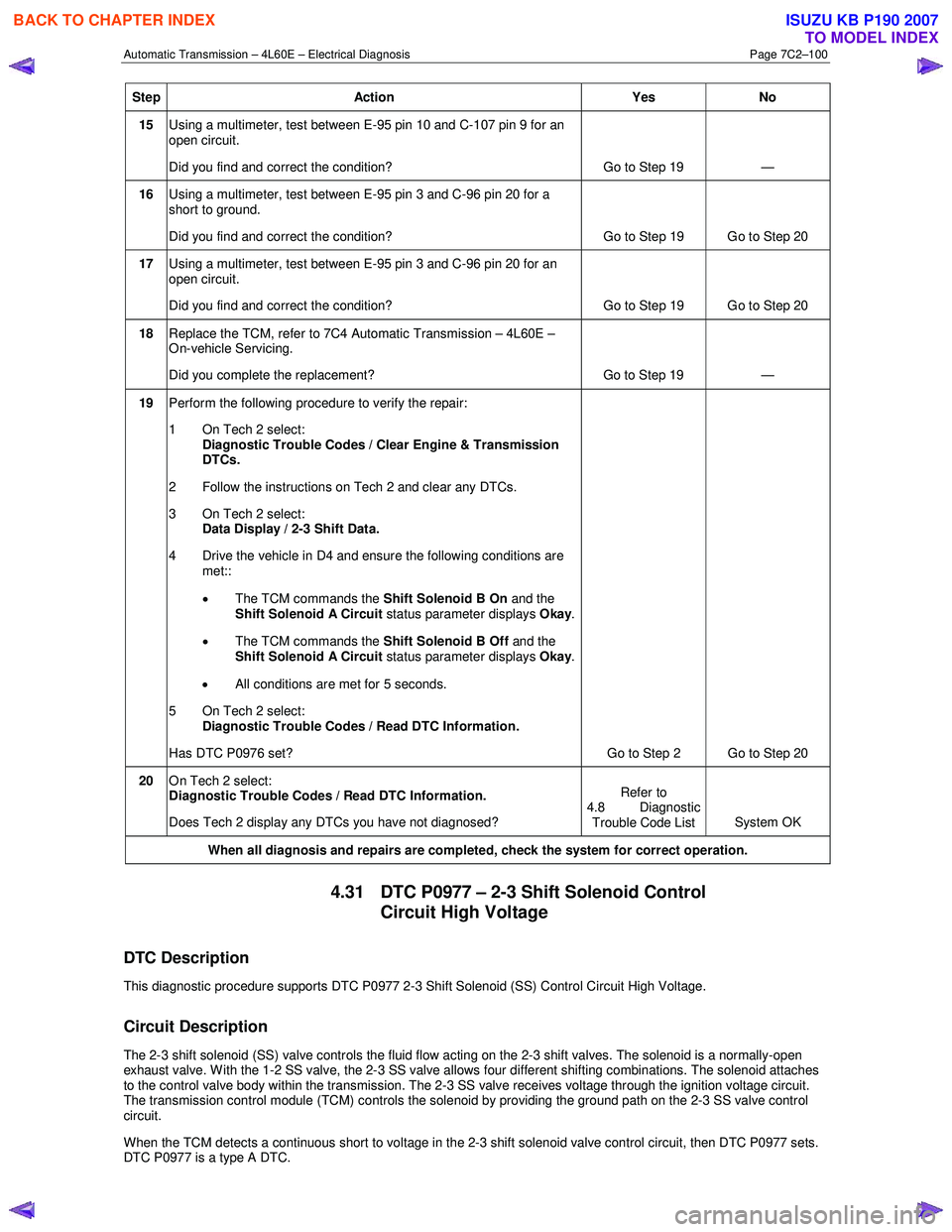
Automatic Transmission – 4L60E – Electrical Diagnosis Page 7C2–100
Step Action Yes No
15 Using a multimeter, test between E-95 pin 10 and C-107 pin 9 for an
open circuit.
Did you find and correct the condition? Go to Step 19 —
16 Using a multimeter, test between E-95 pin 3 and C-96 pin 20 for a
short to ground.
Did you find and correct the condition? Go to Step 19 Go to Step 20
17 Using a multimeter, test between E-95 pin 3 and C-96 pin 20 for an
open circuit.
Did you find and correct the condition? Go to Step 19 Go to Step 20
18 Replace the TCM, refer to 7C4 Automatic Transmission – 4L60E –
On-vehicle Servicing.
Did you complete the replacement? Go to Step 19 —
19 Perform the following procedure to verify the repair:
1 On Tech 2 select: Diagnostic Trouble Codes / Clear Engine & Transmission
DTCs.
2 Follow the instructions on Tech 2 and clear any DTCs.
3 On Tech 2 select: Data Display / 2-3 Shift Data.
4 Drive the vehicle in D4 and ensure the following conditions are met::
• The TCM commands the Shift Solenoid B On and the
Shift Solenoid A Circuit status parameter displays Okay.
• The TCM commands the Shift Solenoid B Off and the
Shift Solenoid A Circuit status parameter displays Okay.
• All conditions are met for 5 seconds.
5 On Tech 2 select:
Diagnostic Trouble Codes / Read DTC Information.
Has DTC P0976 set? Go to Step 2 Go to Step 20
20 On Tech 2 select:
Diagnostic Trouble Codes / Read DTC Information.
Does Tech 2 display any DTCs you have not diagnosed? Refer to
4.8 Diagnostic Trouble Code List System OK
When all diagnosis and repairs are completed, check the
system for correct operation.
4.31 DTC P0977 – 2-3 Shift Solenoid Control
Circuit High Voltage
DTC Description
This diagnostic procedure supports DTC P0977 2-3 Shift Solenoid (SS) Control Circuit High Voltage.
Circuit Description
The 2-3 shift solenoid (SS) valve controls the fluid flow acting on the 2-3 shift valves. The solenoid is a normally-open
exhaust valve. W ith the 1-2 SS valve, the 2-3 SS valve allows four different shifting combinations. The solenoid attaches
to the control valve body within the transmission. The 2-3 SS valve receives voltage through the ignition voltage circuit.
The transmission control module (TCM) controls the solenoid by providing the ground path on the 2-3 SS valve control
circuit.
When the TCM detects a continuous short to voltage in the 2-3 shift solenoid valve control circuit, then DTC P0977 sets.
DTC P0977 is a type A DTC.
BACK TO CHAPTER INDEX
TO MODEL INDEX
ISUZU KB P190 2007
Page 3889 of 6020
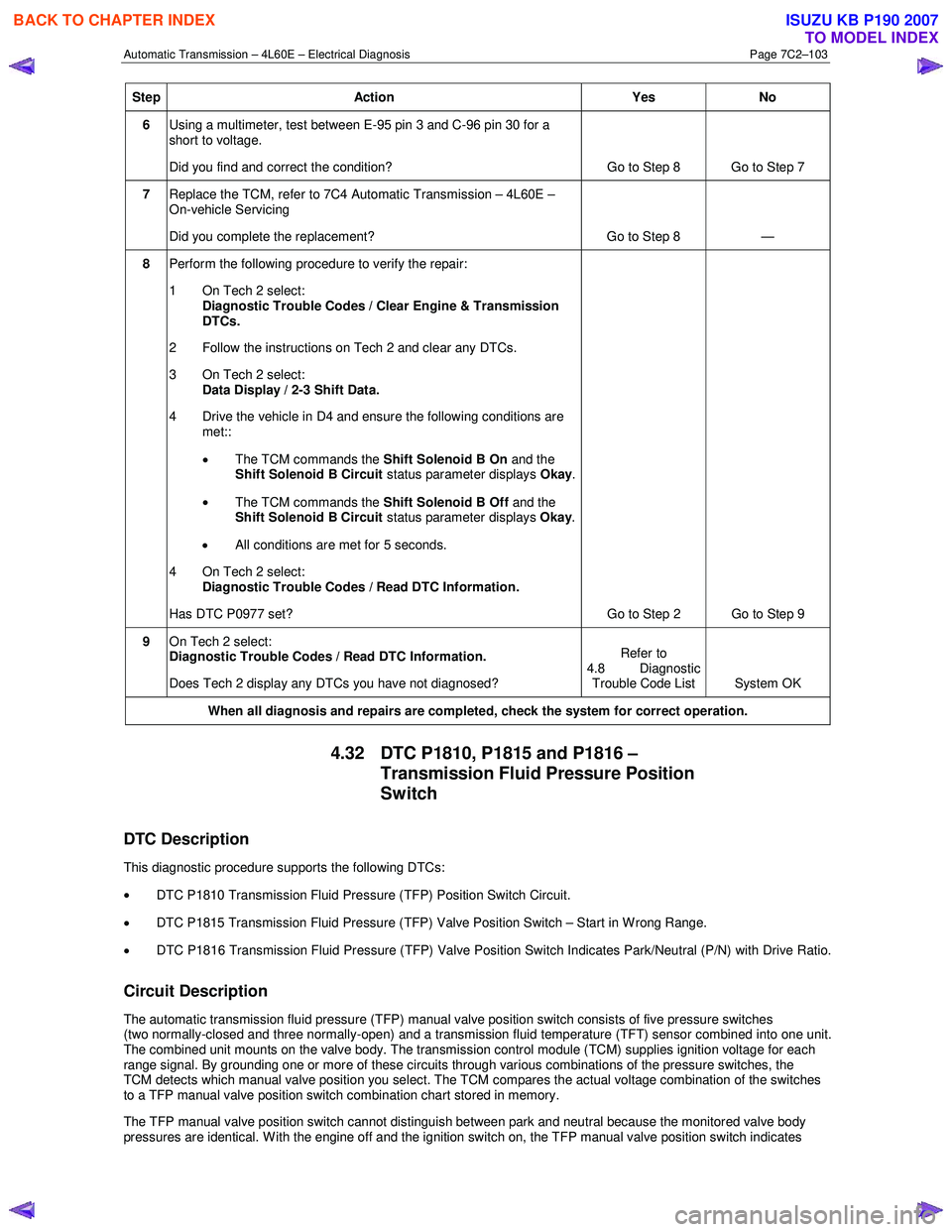
Automatic Transmission – 4L60E – Electrical Diagnosis Page 7C2–103
Step Action Yes No
6 Using a multimeter, test between E-95 pin 3 and C-96 pin 30 for a
short to voltage.
Did you find and correct the condition? Go to Step 8 Go to Step 7
7 Replace the TCM, refer to 7C4 Automatic Transmission – 4L60E –
On-vehicle Servicing
Did you complete the replacement? Go to Step 8 —
8 Perform the following procedure to verify the repair:
1 On Tech 2 select: Diagnostic Trouble Codes / Clear Engine & Transmission
DTCs.
2 Follow the instructions on Tech 2 and clear any DTCs.
3 On Tech 2 select: Data Display / 2-3 Shift Data.
4 Drive the vehicle in D4 and ensure the following conditions are met::
• The TCM commands the Shift Solenoid B On and the
Shift Solenoid B Circuit status parameter displays Okay.
• The TCM commands the Shift Solenoid B Off and the
Shift Solenoid B Circuit status parameter displays Okay.
• All conditions are met for 5 seconds.
4 On Tech 2 select:
Diagnostic Trouble Codes / Read DTC Information.
Has DTC P0977 set? Go to Step 2 Go to Step 9
9 On Tech 2 select:
Diagnostic Trouble Codes / Read DTC Information.
Does Tech 2 display any DTCs you have not diagnosed? Refer to
4.8 Diagnostic Trouble Code List System OK
When all diagnosis and repairs are completed, check the
system for correct operation.
4.32 DTC P1810, P1815 and P1816 –
Transmission Fluid Pressure Position
Switch
DTC Description
This diagnostic procedure supports the following DTCs:
• DTC P1810 Transmission Fluid Pressure (TFP) Position Switch Circuit.
• DTC P1815 Transmission Fluid Pressure (TFP) Valve Position Switch – Start in W rong Range.
• DTC P1816 Transmission Fluid Pressure (TFP) Valve Position Switch Indicates Park/Neutral (P/N) with Drive Ratio.
Circuit Description
The automatic transmission fluid pressure (TFP) manual valve position switch consists of five pressure switches
(two normally-closed and three normally-open) and a transmission fluid temperature (TFT) sensor combined into one unit.
The combined unit mounts on the valve body. The transmission control module (TCM) supplies ignition voltage for each
range signal. By grounding one or more of these circuits through various combinations of the pressure switches, the
TCM detects which manual valve position you select. The TCM compares the actual voltage combination of the switches
to a TFP manual valve position switch combination chart stored in memory.
The TFP manual valve position switch cannot distinguish between park and neutral because the monitored valve body
pressures are identical. W ith the engine off and the ignition switch on, the TFP manual valve position switch indicates
BACK TO CHAPTER INDEX
TO MODEL INDEX
ISUZU KB P190 2007
Page 3891 of 6020

Automatic Transmission – 4L60E – Electrical Diagnosis Page 7C2–105
• The TCM commands 4th gear.
• At the time of the first failure, the TCM records the operating conditions when the conditions for setting the DTC are
met. The TCM stores this information as a Failure Record.
• At the time of the second failure, the ECM records the operating conditions when the conditions for setting the DTC
are met. The ECM stores this information as a Freeze Frame.
• The TCM stores the DTC in TCM history during the second consecutive trip in which the conditions for setting the
DTC are met.
Conditions for Clearing the DTC
• The ECM turns off the MIL after the fourth consecutive drive trip in which the TCM does not send a MIL illumination
request.
• Tech 2 can clear the DTC.
• The TCM clears the DTC from TCM history if the vehicle completes 40 warm-up cycles without a non-emission
related diagnostic fault occurring.
• The TCM cancels the DTC default actions when the ignition is off long enough to power down the TCM.
Diagnostic Aids
• Refer to the 5.3 Transmission Fluid Pressure Manual Valve Position Switch Logic for the normal range signals
and the invalid combinations. On the table, LOW is 0 V, HI is ignition voltage.
• Sediment in the valve body may cause improper operation of the TFP manual valve position switch. If the presence
of sediment is suspected, clean the valve body and replace the TFP manual valve position switch.
Test Description
The following numbers refer to the step numbers in the diagnostic table:
3 Checks the indicated range signal to the selected manual valve position.
4-5 Checks for correct voltage from the TCM to the transmission inline 20-way connector.
6 Checks if there is a short between any of the signal circuits.
DTC P1810, P1815 and P1816 Diagnostic Table
Step Action Yes No
1 Has the Diagnostic System Check been performed?
Go to Step 2 Refer to
4.7 Diagnostic System Check
2 Inspect for correct transmission fluid level, refer to 7C4 Automatic
Transmission – 4L60E – On-vehicle Servicing.
Did you perform the fluid checking procedure? Go to Step 3 Refer to
7C4 Automatic
Transmission –
4L60E – On-vehicle Servicing
BACK TO CHAPTER INDEX
TO MODEL INDEX
ISUZU KB P190 2007
Page 3894 of 6020
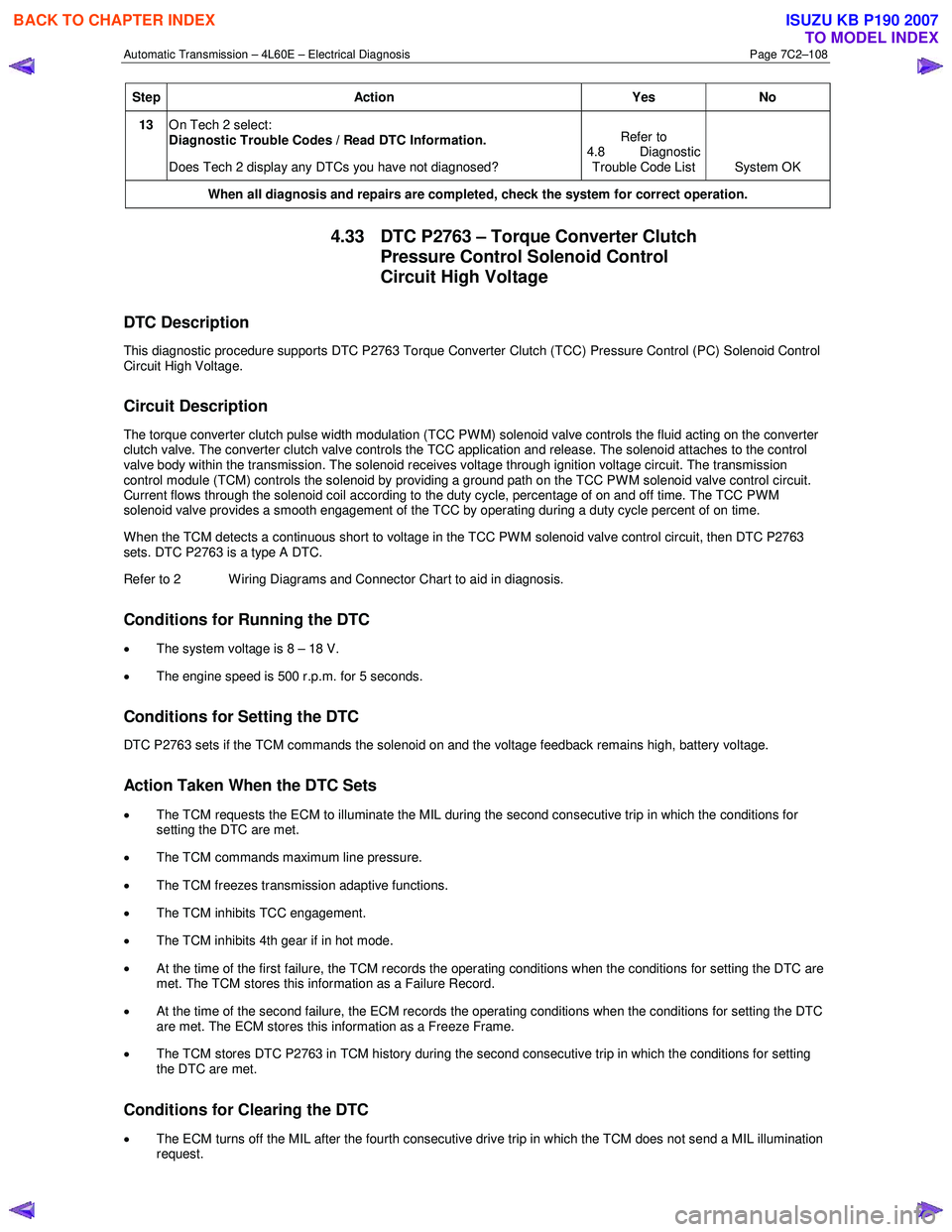
Automatic Transmission – 4L60E – Electrical Diagnosis Page 7C2–108
Step Action Yes No
13 On Tech 2 select:
Diagnostic Trouble Codes / Read DTC Information.
Does Tech 2 display any DTCs you have not diagnosed? Refer to
4.8 Diagnostic Trouble Code List System OK
When all diagnosis and repairs are completed, check the system for correct operation.
4.33 DTC P2763 – Torque Converter Clutch
Pressure Control Solenoid Control
Circuit High Voltage
DTC Description
This diagnostic procedure supports DTC P2763 Torque Converter Clutch (TCC) Pressure Control (PC) Solenoid Control
Circuit High Voltage.
Circuit Description
The torque converter clutch pulse width modulation (TCC PW M) solenoid valve controls the fluid acting on the converter
clutch valve. The converter clutch valve controls the TCC application and release. The solenoid attaches to the control
valve body within the transmission. The solenoid receives voltage through ignition voltage circuit. The transmission
control module (TCM) controls the solenoid by providing a ground path on the TCC PW M solenoid valve control circuit.
Current flows through the solenoid coil according to the duty cycle, percentage of on and off time. The TCC PWM
solenoid valve provides a smooth engagement of the TCC by operating during a duty cycle percent of on time.
When the TCM detects a continuous short to voltage in the TCC PW M solenoid valve control circuit, then DTC P2763
sets. DTC P2763 is a type A DTC.
Refer to 2 W iring Diagrams and Connector Chart to aid in diagnosis.
Conditions for Running the DTC
• The system voltage is 8 – 18 V.
• The engine speed is 500 r.p.m. for 5 seconds.
Conditions for Setting the DTC
DTC P2763 sets if the TCM commands the solenoid on and the voltage feedback remains high, battery voltage.
Action Taken When the DTC Sets
• The TCM requests the ECM to illuminate the MIL during the second consecutive trip in which the conditions for
setting the DTC are met.
• The TCM commands maximum line pressure.
• The TCM freezes transmission adaptive functions.
• The TCM inhibits TCC engagement.
• The TCM inhibits 4th gear if in hot mode.
• At the time of the first failure, the TCM records the operating conditions when the conditions for setting the DTC are
met. The TCM stores this information as a Failure Record.
• At the time of the second failure, the ECM records the operating conditions when the conditions for setting the DTC
are met. The ECM stores this information as a Freeze Frame.
• The TCM stores DTC P2763 in TCM history during the second consecutive trip in which the conditions for setting
the DTC are met.
Conditions for Clearing the DTC
• The ECM turns off the MIL after the fourth consecutive drive trip in which the TCM does not send a MIL illumination
request.
BACK TO CHAPTER INDEX
TO MODEL INDEX
ISUZU KB P190 2007
Page 3919 of 6020

Automatic Transmission – 4L60E – On-vehicle Servicing Page 7C4–6
6 Lift the locking lever (1) on the transmission fluid
indicator, then remove the indicator from the filler
tube (2) and check the fluid colour, condition and level.
Do not overfill the transmission. Overfilling
can cause aeration resulting in fluid loss,
shift complaints and possible damage to the
transmission.
7 If the transmission fluid level is low, add only enough of the recommended fluid until
its level shows onto the
crosshatch hot area (3) of the fluid indicator.
Figure 7C4 – 1
2.2 Reverse Flush and Flow Rate Test
It is essential to perform a reverse flush and oil cooler flow rate test after any of the following:
• the transmission is repaired or replaced,
• fluid contamination is suspected, or
• whenever the oil pump and/or torque converter is replaced.
NOTE
The reverse flush must be completed prior to
conducting a flow rate test.
Reverse Flush
1 Disconnect both cooler hose/line assemblies at the transmission and at the radiator cooler, refer to 3.17 Transmission Cooler Line/Hose Assemblies.
2 Check the cooler hose/line to radiator cooler fittings for damage, replace as required.
To avoid personal injury, wear safety glasses
when using compressed air.
3 Carefully check the radiator cooler lower fitting to see if any foreign material is evident at this point. If foreign material is found, remove it with a suitable tool and/or compressed air at a reduced pressure of approximately
345 kPa blown in the reverse direction through the cooler.
4 Using compressed air at a reduced pressure of approximately 345 kPa blown in a reverse direction, clean the cooler hose/line assemblies.
5 Reconnect the cooler outlet line to the transmission and both cooler hose/line assemblies to the radiator cooler fittings, refer to 3.17 Transmission Cooler Line/Hose Assemblies.
NOTE
Do not reconnect the cooler inlet line at the
transmission end. This line needs to be left
disconnected to perform the flow rate test.
6 Perform the flow rate test, refer to Flow Rate Test in this Section.
BACK TO CHAPTER INDEX
TO MODEL INDEX
ISUZU KB P190 2007